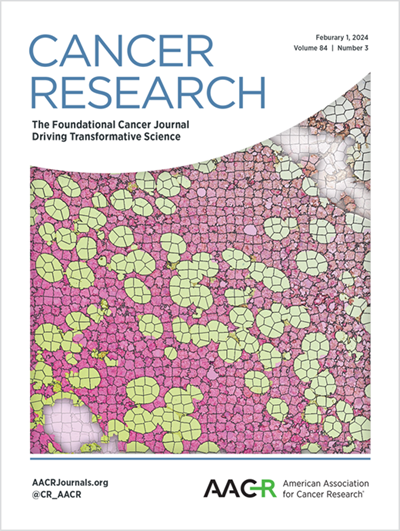LB370:肿瘤浸润性淋巴细胞衍生的CD8克隆型浸润肿瘤组织并介导胶质母细胞瘤的肿瘤消退
IF 12.5
1区 医学
Q1 ONCOLOGY
引用次数: 0
摘要
利用肿瘤浸润淋巴细胞(TILs)进行的适应性细胞疗法在治疗黑色素瘤和其他以高肿瘤突变负荷(TMB)为特征的 "热点 "肿瘤方面显示出显著疗效。然而,由于免疫抑制性肿瘤微环境、抗原递呈缺陷和限制性血脑屏障,胶质瘤的TMB与免疫疗法的疗效之间没有明确的相关性,从而阻碍了免疫疗法的有效性。我们报告了使用由IL-2、IL-15和IL-21组成的特定鸡尾酒细胞因子扩增TIL成功治疗一名进展迅速的高TMB胶质母细胞瘤患者的情况。治疗方案包括在TIL静脉输注前使用单剂量环磷酰胺进行淋巴清除,然后在输注后使用单剂量IL-2。值得注意的是,两次TIL输注间隔两周后,肿瘤完全消退。顺序头颅磁共振成像显示,第二次输注后 22 天,肿瘤完全消退,肿瘤活检显示组织完全坏死。TIL产物富含CD8 T细胞,具有高IFNg生成和CD107a表达。它们对自体肿瘤细胞系表现出剂量依赖性的特异性细胞溶解活性,但对自体EBV转化的B细胞系、异体胶质母细胞瘤细胞系U-373和DBTRG05或无关的Daudi B细胞淋巴瘤细胞系没有活性。输注TIL后,外周血T细胞表现出TCR下调,表明T细胞活化,同时效应记忆CD8 T细胞、CD4 Th1和Th17亚型数量增加,而终末分化的CD8 T细胞数量减少。每次输注TIL后,血清中IL-6和sIL-2R的水平都会激增,这证实了全身T细胞的强烈活化。血液学分析显示,尽管使用了减量治疗方案,但淋巴细胞仍持续减少。通过全外显子组测序(WES)、RNA-seq和T细胞受体(TCR)新一代测序分析了TIL输注前后采集的手术肿瘤样本。WES显示所有样本都存在高突变负荷(>10/Mb),包括表皮生长因子受体(EGFR)、TP53和BRCA1/2的突变。灌注后肿瘤活检的转录组分析表明,与免疫突触形成和T细胞效应功能相关的基因表达增强,这与观察到的临床反应一致。TCR测序表明,TIL衍生的CD8 T细胞有效浸润了肿瘤组织,并与肿瘤清除密切相关。肿瘤内的超扩增克隆型表明体内TIL扩增强劲,突出了TIL衍生的CD8 T细胞增殖对肿瘤控制的重要贡献。CD4 T细胞尽管比CD8 T细胞在输注产品中表现出更大的TCR多样性,但浸润程度有限。该病例突出显示了用IL-2/IL-15/IL-21扩增的TIL在克服胶质母细胞瘤免疫抑制微环境的挑战、取得显著临床疗效方面的潜力。这些研究结果支持将基于TIL的优化疗法作为胶质母细胞瘤和其他 "冷 "肿瘤的可行治疗策略。引用格式:Lucas C M Arruda, Julia Karbach, Dragan Kiselicki, Hans-Michael Altmannsberger, Evgueni Sinelnikov, Dirk Gustavus, Hans Hoffmeister, Akin Atmaca, Elke Jäger.肿瘤浸润淋巴细胞衍生的CD8克隆型浸润肿瘤组织并介导胶质母细胞瘤的肿瘤消退[摘要]。In:美国癌症研究协会 2025 年年会论文集;第 2 部分(晚期突破、临床试验和特邀论文);2025 年 4 月 25-30 日;伊利诺伊州芝加哥。费城(宾夕法尼亚州):AACR; Cancer Res 2025;85(8_Suppl_2): nr LB370.本文章由计算机程序翻译,如有差异,请以英文原文为准。
Abstract LB370: Tumor-infiltrating lymphocytes-derived CD8 clonotypes infiltrate the tumor tissue and mediate tumor regression in glioblastoma
Adoptive cell therapy using tumor-infiltrating lymphocytes (TILs) has shown remarkable efficacy in treating melanoma and other "hot" tumors characterized by high tumor mutation burden (TMB), a biomarker increasingly recognized for predicting immunotherapy success in solid tumors. However, gliomas show no clear correlation between TMB and immunotherapy efficacy due to the immunosuppressive tumor microenvironment, defective antigen presentation and the restrictive blood-brain barrier, hindering the effectiveness of immunotherapy. We report the successful treatment of a rapidly progressing high-TMB glioblastoma patient with TILs expanded using a defined cytokine cocktail comprising IL-2, IL-15, and IL-21. The therapeutic regimen included lymphodepletion with a single dose of cyclophosphamide prior to TIL intravenous infusion followed by a single dose of IL-2 post-infusion. Remarkably, complete tumor regression was achieved following two TIL infusions administered two weeks apart. Sequential cranial MRI showed complete tumor remission 22 days after the second infusion, with biopsies of the tumor showing complete necrotic tissue transformation. The TIL products were enriched for CD8 T-cells with high IFNg production and CD107a expression. They exhibited dose-dependent, specific cytolytic activity against autologous tumor cell lines but not against an autologous EBV-transformed B-cell line, the allogeneic glioblastoma cell lines U-373 and DBTRG05, or the unrelated Daudi B-cell lymphoma cell line. After TIL infusion, peripheral blood T-cells exhibited TCR downregulation, indicating activation, alongside with increased numbers of effector memory CD8 T-cells and CD4 Th1 and Th17 subtypes, while terminally differentiated CD8 T-cells decreased. A surge in serum IL-6 and sIL-2R levels was seen after each TIL infusion, confirming the strong systemic T-cell activation. Hematological analyses revealed persistent lymphopenia despite the use of reduced conditioning regimen. Surgical tumor samples collected before and after TIL infusions were analyzed by whole-exome sequencing (WES), RNA-seq and T-cell receptor (TCR) next-generation sequencing. WES revealed a high mutation burden (>10/Mb) across all samples, including mutations on EGFR, TP53 and BRCA1/2. Transcriptomic analysis of post-infusion tumor biopsies demonstrated enhanced expression of genes associated with immunological synapse formation and T-cell effector function, in line with the observed clinical response. TCR sequencing demonstrated that TIL-derived CD8 T-cells effectively infiltrated the tumor tissue and were strongly associated with tumor clearance. Hyperexpanded clonotypes within the tumor indicated robust TIL expansion in vivo, highlighting the significant contribution of TIL-derived CD8 T-cell proliferation to tumor control. CD4 T-cells, despite presenting greater TCR diversity than CD8 T-cells within the infused product, showed limited infiltration. This case highlights the potential of TILs expanded with IL-2/IL-15/IL-21 to overcome the challenges of glioblastoma’s immunosuppressive microenvironment, achieving significant clinical outcomes. These findings support the exploration of optimized TIL-based therapies as a viable treatment strategy for glioblastoma and other "cold" tumors. Citation Format: Lucas C M Arruda, Julia Karbach, Dragan Kiselicki, Hans-Michael Altmannsberger, Evgueni Sinelnikov, Dirk Gustavus, Hans Hoffmeister, Akin Atmaca, Elke Jäger. Tumor-infiltrating lymphocytes-derived CD8 clonotypes infiltrate the tumor tissue and mediate tumor regression in glioblastoma [abstract]. In: Proceedings of the American Association for Cancer Research Annual Meeting 2025; Part 2 (Late-Breaking, Clinical Trial, and Invited s); 2025 Apr 25-30; Chicago, IL. Philadelphia (PA): AACR; Cancer Res 2025;85(8_Suppl_2): nr LB370.
求助全文
通过发布文献求助,成功后即可免费获取论文全文。
去求助
来源期刊

Cancer research
医学-肿瘤学
CiteScore
16.10
自引率
0.90%
发文量
7677
审稿时长
2.5 months
期刊介绍:
Cancer Research, published by the American Association for Cancer Research (AACR), is a journal that focuses on impactful original studies, reviews, and opinion pieces relevant to the broad cancer research community. Manuscripts that present conceptual or technological advances leading to insights into cancer biology are particularly sought after. The journal also places emphasis on convergence science, which involves bridging multiple distinct areas of cancer research.
With primary subsections including Cancer Biology, Cancer Immunology, Cancer Metabolism and Molecular Mechanisms, Translational Cancer Biology, Cancer Landscapes, and Convergence Science, Cancer Research has a comprehensive scope. It is published twice a month and has one volume per year, with a print ISSN of 0008-5472 and an online ISSN of 1538-7445.
Cancer Research is abstracted and/or indexed in various databases and platforms, including BIOSIS Previews (R) Database, MEDLINE, Current Contents/Life Sciences, Current Contents/Clinical Medicine, Science Citation Index, Scopus, and Web of Science.
 求助内容:
求助内容: 应助结果提醒方式:
应助结果提醒方式:


